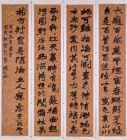Japanese Archaeology and Special Exhibition (Heiseikan) Thematic Exhibition Room
August 4, 2009 (Tue) - September 27, 2009 (Sun)
During the 19th century in Qing-dynasty China, a new style of calligraphy was born based on the development of academic studies on epigraphs from preceding eras. Zhao Zhiqian (1829 - 84) played a central role in this innovation.
Zhao was born to a wealthy family in Shaoxing, Zhejiang province, although in his childhood, the family suffered poverty as a result of bankruptcy. Later, he studied under the provincial attorney general Miao Zi and passed the first stage of the civil service examinations. As the battles of the Taiping Rebellion reached Hangzhou, however, not only his wife and daughter but also his mentor Miao Zi died as a result of war. He also lost his home in Shaoxing, which was burnt down at this time.
From the following year, Zhao continued his attempts to pass the final stage of the civil service examinations, but all ended in failure. He thus abandoned his dream to become a high class bureaucrat in the central government. Instead, he became a local official in Nanchang, Jianxi province, and completed The General History of Jianxi Province. He was later appointed to places across Jianxi as a provincial administrative official, but died from hard work at the age of 56.
Despite of his extensive academic knowledge, he led a rather unrewarded career. Distressed between ideals and reality, Zhao sublimated his emotions in his calligraphy, paintings and seal carvings, which are now known for their uniquely expressive styles.
While in Beijing in his younger years preparing for the examinations, Zhao came to know Hu Shu (1825 - 72), Shen Shuyong (1832 - 73) and Wei Xizeng (? - 1881), and became absorbed in epigraphic studies which was popular at the time. This transformed his writing style dramatically. Inspired greatly by the calligraphy of the Northern Wei dynasty (386 - 534), he achieved a revolutionary style which came to be known as the Northern Wei style. It can be said that the Stele School, which studied ancient Chinese characters from epigraphs to create novel calligraphic styles, reached its peak with the appearance of Zhao Zhiqian.
This thematic exhibition, celebrating the 180th anniversary of Zhao Zhiqian's birth, focuses on works by Zhao Zhiqian to present an overview of the history of the Stele School which flourished in the later half of the Qing dynasty. A great influence on later calligraphers and still popular today, the work of Zhao Zhiqian is highlighted in this exhibition, which marks our seventh collaboration with the Calligraphy Museum.
*Rotation of works is scheduled; the second period of the exhibition begins on Tuesday, September 1, 2009.

